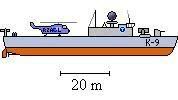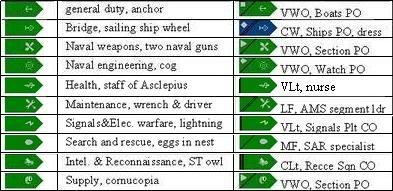Difference between revisions of "CDF Naval Service"
(Major rewrite, reorg, added Naval Reseve and added illus.) |
(→Mobilisation) |
||
| Line 67: | Line 67: | ||
==Mobilisation== | ==Mobilisation== | ||
| − | + | Much more than its land and air counterparts, the Naval Service is tied to its equipment and cannot be easily or quickly expanded. Warships typically take at least a year from keel laying to commissioning, and even longer for capital ships like [[Community Vessel Aircraft Carrier|carriers]] and [[Community Vessel Cruiser|cruisers]]. However, a quick and dirty anti-submarine fix can be had by the mass production of [[Community Vessel Corvette|corvettes]]. | |
| − | |- | + | |
| − | | | + | |
| − | + | ||
http://i8.photobucket.com/albums/a6/extrememoderate/Corvette.jpg | http://i8.photobucket.com/albums/a6/extrememoderate/Corvette.jpg | ||
| − | |||
| − | |||
| − | |||
The Chief of the Naval Staff, with the consent of the Minister of Community Defence, may call out the Naval Reserve at any time. During times of crisis or war, recent naval veterans and experienced mariners without naval experience may be conscripted into the Naval Reserve and placed on active duty. | The Chief of the Naval Staff, with the consent of the Minister of Community Defence, may call out the Naval Reserve at any time. During times of crisis or war, recent naval veterans and experienced mariners without naval experience may be conscripted into the Naval Reserve and placed on active duty. | ||
Revision as of 21:28, 6 June 2006
This article is about a branch of the armed forces of Sober Thought. For discussions about armed forces generally, see Category:Armed forces.
The Naval Service of Sober Thought is the navy arm of service in the Community Defence Forces. The twin functions of the CDF Naval Service are to transport troops of the CDF Land Service to their overseas destinations and prevent hostile troops from landing on the shores of Sober Thought. All other functions are designed to further these two goals.
Vessels
See also article: CDF naval naming conventions.
To meet the goals of the first function, for every one hundred million national population there are three troop transports (together capable of transporting a division's worth of troops into friendly harbours) and nine landing ships (together capable of transporting about four brigades’ worth of troops onto hostile beaches). Air defence or force projection, the major portion of the second function, is provided by aircraft carriers and their embarked carrier air groups.
The remainder of the combat fleet is prepared for anti-submarine warfare and is comprised of: cruisers, destroyers, frigates, submarines or undersea boats, fast patrol boats and mine warfare boats. The first three ships listed above can, with decreasing effectiveness, also engage in gunnery attacks on surface or shore targets. See Mobilisation below for a discussion of corvettes.
All surface ships may be refuelled or reprovisioned at sea by the nine supply ships per 100 million population. Additionally, two frigate hulls have been adapted as small craft tenders to support fast patrol boats and minelayer/hunters on extended operations.
Branches
| Branch Insignia in the Naval Service |
The organisation of the Naval Service's branches most closely resembles that of the Air Service, since several branches are represented on every vessel while in the Land Service, most units have one (or mostly one) branch within it. The Bridge Branch includes navigation, command, radar, communications and similar functions. Sailors wear their branch insignia on their shoulderboards or epaulettes.
The Naval Weapons Branch includes all sorts of offensive and defensive weapons, such as anti-ship guns and rockets, anti-aircraft guns and rockets, and anti-submarine mortars, mines and rockets.
The Naval Engineering Branch is primarily concerned with keeping the engines, hull and superstructure of various vessels in working order. Similar but separate functions are performed by members of the tri-service Maintenance Branch and Engineering Branch on the contents of the larger of these vessels.
Main article: CDF naval aviation.
In order to protect troop transports and the soldiers embarked upon them from air threat, the naval air arm, nominally part of the CDF Air Service, is especially strong. Each hundred million of population supports one Naval Air Division comprised of one air group each based on aircraft carriers, naval escorts (cruisers, destroyers, frigates and tenders) sealift (landing ships, supply ships and troopships) and coastal defence bases.
The aircraft carrier has more fliers than sailors aboard its 70 000 tonne and 320 m long hull. Under the overall command of a Vice Marshal, it projects air power to distant shores, provides a combat air screen for large embarked fleets, and provides ground attack to support large amphibious landings. It is mainly armed with the FN-1 Faina variable geometry and F-22 Faith vertical/short take off and landing fighters, the former of which is equipped with arrestor hooks for carrier landings.
The underwater threat is partly minimized by anti-submarine helicopters aboard each surface ship from corvette to carrier. These ASW workhorses are also present in the Coastal Defence Air Group, which also has the propeller driven fixed wing RB-78 Robert for long range and long term airborne reconnaissance and anti-submarine air attack.
Naturally, the landing ships' composite helicopter squadrons are heavily weighted towards rotary wing aircraft suitable for supporting an amphibious landing rather than ASW.
Marines
Each one hundred million population also supports one Marine Division which is nominally part of the CDF Land Service but is always under naval command. It is numbered in its own sequence, so that the division number always equals the population wave number. It consists of three sequentially numbered field brigades, three support brigades and about 14 000 all ranks under a Vice Marshal.
The 1st Marine Brigade consists of about 3 800 light infantry, with at least three of six battalions afloat. The 1 274 marines permanently stationed on warships are under the command of each individual ship's captain. They are there to provide boarding parties and internal security so they are mainly armed with 9 mm submachine guns appropriate to the often confined spaces on small warships. Their default allotment is:
- Frigates - a squad of 11 marines (totalling 264 per wave)
- Destroyers - a platoon of 35 (420, one notional battalion on destroyers and frigates collectively)
- Cruisers - a company of 115 (690, one notional battalion)
- Aircraft carrier - one battalion of 565
- Shore - three battalions totalling 1 695
The 2nd Marine Brigade consists of about 1 800 tankers with at least two of four battalions afloat on nine landing ships. The 3rd Marine Brigade consists of about 2 800 armoured infantry with at least one of four battalions afloat on nine landing ships. Combat support and service support troops numbering about 5 600 remain mainly on land but are used to round out the division or its brigade groups.
After membership in the fulltime voluntary enlistment Naval Service, sailors of all ranks may apply for membership in the CDF Naval Reserve. Those with skilled naval and marine trades which take a long time to develop, and those with the best command ability and potential, are most likely to be successful candidates.
The Naval Reserve conducts refresher training for about two weeks each year in the naval application of a sailor’s specifc maritime trade. For instance, a navigator on a merchant vessel would practice navigation on a frequent basis in civilian employ and would require no special training for this; however the Naval Reserve navigator would benefit from refresher training in naval navigation technology, convoy techniques and naval command authority.
The Naval Reserve is best known for its fleet auxiliaries -- merchant marine vessels with explicit dual civilian-naval uses -- and merchant ships -- civilian vessels with implicit dual uses. Together, these ships provide fleet support and forces supply for the regular Community Defence Forces, the reserve CDF and the CDF Civil Guard when on federal service.
Besides these largely unarmed vessels, the Naval Reserve is responsible for providing the majority of wartime crew on corvettes (built only in wartime), tenders, minelayers, minehunters, minesweepers, fast patrol boat, gate vessels, tugboats and other port watercraft. It may also provided individual crew members or small sub-sections to larger regular Naval Service combat and supply vessels.
Mobilisation
Much more than its land and air counterparts, the Naval Service is tied to its equipment and cannot be easily or quickly expanded. Warships typically take at least a year from keel laying to commissioning, and even longer for capital ships like carriers and cruisers. However, a quick and dirty anti-submarine fix can be had by the mass production of corvettes.

The Chief of the Naval Staff, with the consent of the Minister of Community Defence, may call out the Naval Reserve at any time. During times of crisis or war, recent naval veterans and experienced mariners without naval experience may be conscripted into the Naval Reserve and placed on active duty.
Sailors through chief petty officers who were discharged honourably and medically fit in the last five years and who are aged no more than 30 are prime candidates for conscription into the Naval Reserve. While mainly used as individual replacements for existing large Community Vessels, they are also used to crew new fast patrol boats, minesweepers/layers and tenders. Most importantly, however, they provide most crewmembers for the cheaply and quickly manufactured corvettes.

